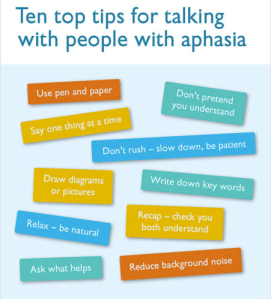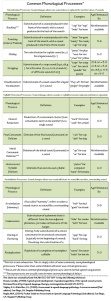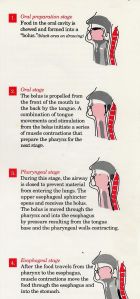The Assessment
– Gather information: Review their chart thoroughly, conduct an interview with the client, consider psychological and situational factors (are they refusing to eat? do they have reflux? what is their eating environment like? what is their cognitive status and alertness?)
– Oral Mechanism Exam: Have the client execute a number of speech and non-speech oral movements, such as sticking out their tongue, rapidly saying /pa/ or /ka/ or /ta/, phonating, etc. Look for unilateral or bilateral weakness or incoordination in their movements, if they appear to have sensation of food or saliva in or around their mouth, and listen for frequent throat clearing and coughing which may indicate laryngeal or pharyngeal weakness.
– Presentation of Foods and Liquids: Start with small bites of an easy-to-eat food, such as applesauce or something pureed. Progress to foods that are harder to eat (chewier, crunchier, etc.) Clinically assess their swallowing ability and make decision if they should be place on restricted diet/liquids or if further evaluation is necessary. Do they have anterior or posterior leakage as they eat? Do they have the ability to chew sufficiently? How well do they clean mouth after eating? Is there pocketing of food? Do they have coughing or gurgling or wet vocal quality after swallowing? Do they have sufficient laryngeal elevation to swallow properly?
Formal Tests:
- Bedside Evaluation of Dysphagia (BED)
- Dysphagia Evaluation Protocol
- Quick Assessment for Dysphagia
- Swallowing Abilities and Function Assessment (SAFE)
Informal Assessment Tools:
- Observe the patient as they swallow.
- Does food fall out their mouth as they are chewing/swallowing?
- Is their food not chewed properly?
- Does it take them a long time to chew and swallow?
- Is there excessive residue left in their mouth after they swallow?
- Is their posterior leakage as they are about to swallow?
- Are they doing any excessive tongue pumping?
- Is their laryngeal elevation insufficient?
- Are they coughing, choking or have a wet vocal quality after they swallow?
- Do they have watery eyes or sneezing after they swallow?
- Observe the patient’s oral strength, coordination, range of motion, and symmetry.
(Class notes, SPAUD 501)
Interview Questions:
| Do you have difficulty swallowing? In what way? |
| Is the swallowing difficulty greater for solids or liquids? |
| Do you have this sensation without swallowing food? |
| How long has swallowing difficulty been present? |
| Can you localize the dysphagia? |
| Has heartburn been associated with the dysphagia? |
| Is swallowing painful? |
| Do you get chest pain? |
| Does food get stuck when you swallow? |
| Do you choke or cough with swallowing? |
| Is there temperature sensitivity to dysphagia (especially cold)? |
| Has there been weight loss? |
http://www.ncbi.nlm.nih.gov/books/NBK408/
Swallowing Studies:
Normal swallow: https://www.youtube.com/watch/?v=PwVreNrTKBw
Abnormal swallow with aspiration: http://www.youtube.com/watch?v=1sFNMk87558







